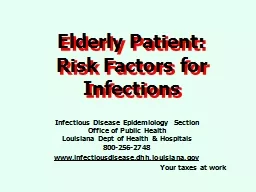

Infectious Disease Epidemiology Section Office of Public Health Louisiana Dept of Health amp Hospitals 8002562748 wwwinfectiousdiseasedhhlouisianagov Your taxes at work Alterations of Mechanical Barriers to Infection ID: 912208
Download Presentation The PPT/PDF document "Elderly Patient: Risk Factors for Infec..." is the property of its rightful owner. Permission is granted to download and print the materials on this web site for personal, non-commercial use only, and to display it on your personal computer provided you do not modify the materials and that you retain all copyright notices contained in the materials. By downloading content from our website, you accept the terms of this agreement.
Slide1
Elderly Patient: Risk Factors for Infections
Infectious Disease Epidemiology Section
Office of Public Health
Louisiana Dept of Health & Hospitals
800-256-2748
www.infectiousdisease.dhh.louisiana.gov
Your taxes at work
Slide2Alterations of Mechanical Barriers to Infection
Eye
Decreased tears to flush
Decreased lysozyme (bacteriocidal enzyme)Diminished blink reflex > drynessOral cavityDental caries, periodontal diseaseSalivary production depressedAltered tongue performance > potential for aspiration
Slide3Oreal Health & VAPOropharynx
colonization by such as
Staphylococcus
aureus, Streptococcus pneumoniae, and gram-negative rods major risk factor for VAP Within 48 hours of admission to ICU, changes in oral flora to predominantly gram-negative organisms, Dental plaque can provide an environment for colonizationAbnormalities in salivary flow risk for overgrowth in oropharynx. Saliva circulation
mechanical removal of debris and plaque, Saliva contains both innate +specific immune components (lactoferrin, IgA
) Many medications also reduce salivary flow
Xerostomia
(dry mouth): from tubes keeping mouth open
Slide4Respiratory System
Microaspiration
& increased
tracheobronchial tree colonizationIncreased chest diameter /rigidity, weakening of respiratory musclesWeakened coughLow lysozyme /low local
IgA in nasal mucosal secretionsDecreased cilia action from nasopharynx
to bronchioles
Decreased
mucociliary
escalation (swallowing)
Alteration of
mucociliary
transport
Collapse of lower airways
Decreased alveolar macrophage
Decreased elastic tissue surrounding alveoli
Fibrous connective tissue
of rib cage:
broncho
-pm movement,
air exchange,
residual air
At end of expiration, 80 year old has 50% more air left in lungs than 25 year old
Slide5Gastro-Intestinal System
Diminished saliva production & antibacterial components
Delayed esophageal emptying, increased risk of aspiration
Decrease or loss of gastric HCl production (30%) susceptibility to enteric infections (Salmonella, Vibrio)Changes of fecal flora, bacterial overgrowth in small bowelDecreased intestinal mobility: degenerative changes in connective tissue and neuronsReduced production of mucus/mucous epithelial cells & cell lining
Slide6GenitoUrinary
System
Changes in kidney structure & function to decreased urine production
Relaxation of female pelvic floor reduces bladder emptying efficiencyCollection of residual urine or incontinencePostmenopausal atrophic vagina with low pH & increased colonizationBladder outlet obstruction: urethral stricture, neurogenic bladder, prostatic hypertrophy > colonization, chronic bacteriuria, overflow incontinence
Loss of bactericidal prostatic secretions Alterations of bladder mucosal lining, phagocytic cells, secretory
IgA
Alteration of normal mechanical barrier urinary drainage catheters
Slide7Skin & Mucosal Surfaces
Thinning of epidermal /dermal layers
Loss of skin elasticity and strength
Decreased production of sebum and fatty acids w antifungal and antibacterial propertiesColonization facilitated by increase of skin pH Decreased sweat gland production of lysozymeLoss of connective tissue, elastic fibers, subcutaneous fat and blood vessels
Lower oxygen in skin > risk for breakdown / healing delaySkin breakdown from peripheral neuropathies of chronic diseases (diabetes)
Slide8Phagocytic
Polymorphonuclear
PMN leukocyte random migration & opsonization normalOlder macrophage not well stimulated by ‘‘foreign’’ antigensLoss of antimicrobial enzymes in the phagocytesPMN leukocyte intracell enzymes slowed by delayed activationPMN leukocyte delayed activation > cell-mediated immunity impairment
Slide9Diminished functions of T and B lymphocytes
number & % of peripheral blood T lymphocytes
Alteration of T-cell subsets, including helper and suppressorProlonged T-cell life in postmature state response to mitogens
& allogenic cells
response to
heterologous
antigens
delayed hypersensitivity response
frequency of autoantibody production
Abnormal production of
lymphokines
No change in # of circulating B cells but loss of normal response
in antibody production may be due to alterations in
T lymphocytes (helper & suppressor)
Macrophages
B lymphocytes
Slide10Other Risk Factors
Cognitive deficit
Difficulties in eliciting history and symptoms
Decrease in complianceDeficient basic hygieneFecal & Urinary incontinencePolypharmacyMalnutritionMultiple chronic diseases